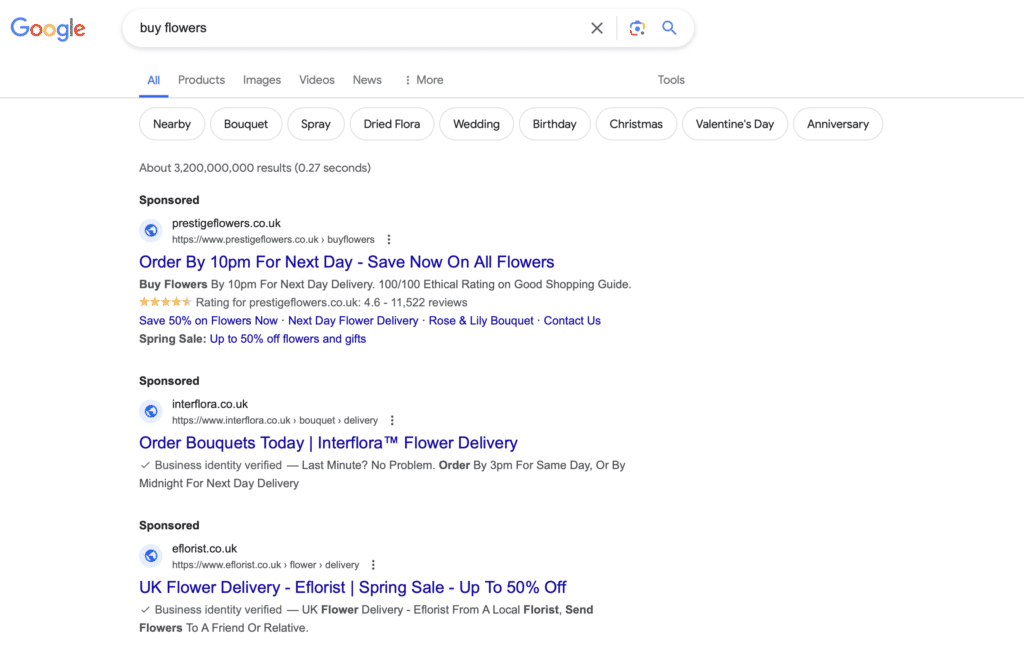Exploring Google Ads: Search Network Vs Display Network
 Reading Time: 7 minutes
Reading Time: 7 minutes
When it comes to advertising online, Google Ads is undoubtedly one of the most powerful tools available to businesses. With the ability to reach millions of users across the globe, Google Ads can help businesses of all sizes increase their online visibility and drive more traffic to their websites. One of the key decisions that businesses need to make when setting up their Google Ads campaigns is whether to focus on the Search Network, the Display Network, or both. In this blog post, we will explore the differences between the two networks and discuss the benefits of using each one.
Table of Contents
Understanding the Basics of Google Ads Networks
Delving into the fundamental aspects of Google Ads Networks and the different types of ads available is pivotal for advertisers looking to harness the platform’s full potential. At its core, Google Ads segregates its advertising capabilities into two primary networks: the Search Network and the Display Network. The former focuses on presenting text-based adverts directly on Google’s search results pages, triggered by specific keywords typed by users. This direct approach aims to connect businesses with potential customers at the very moment they are expressing interest in related products or services.
Conversely, the Display Network takes a broader approach by showcasing visual advertisements across an extensive collection of websites, mobile applications, and video content that are part of Google’s vast network. This network excels in reaching users who might not be actively searching for a business’s products or services but could still be interested once presented with compelling visual ads. The diversity of the Display Network’s reach enables businesses to not only target specific demographics but also engage users across various stages of the digital journey, from awareness to consideration.
Navigating these networks requires a keen understanding of their distinct characteristics and how they can be leveraged to meet different advertising objectives. Advertisers must thoughtfully choose their network—or a combination thereof—based on their campaign goals, whether it’s driving immediate sales or building long-term brand awareness.
The Search Network
The Search Network stands as a crucial platform for enterprises aiming to intercept potential customers during their online search enquiries. This network enables the display of text-based adverts directly within Google’s search outcomes, aligning with the user’s search terms. It’s an invaluable tool for companies seeking immediate engagement from individuals who demonstrate a clear interest in similar products or services by their search behaviour.
Utilising the Search Network allows for a high degree of targeting precision, owing to its reliance on keyword matching. Advertisers can craft campaigns that resonate closely with the search intent of their desired audience, thereby significantly enhancing the likelihood of driving meaningful actions such as enquiries, purchases, or bookings.

This images shows the search results for ”buy flowers” – and shows the results of search ads. From this image we can see that these advertisers have made use of various features within the Google Ads platform, such as using structured snippets and call out extensions for example.
The inherent advantage of this network lies in its ability to place adverts at a critical juncture – when a user is actively seeking information or solutions, providing a prime opportunity for businesses to present themselves as the answer. To capitalise on this opportunity, advertisers must refine their keyword selection, ensuring relevance and intent match, to foster high-quality leads.
Moreover, adeptly managing the Search Network demands a balance between broad reach and specificity, tailoring adverts that not only attract attention but also compel action, without encroaching upon the user’s search experience.
Exploring the Potential of the Display Network
The Display Network serves as an expansive canvas for advertisers aiming to broaden their brand’s visibility. By placing visually appealing advertisements across a myriad array of digital landscapes, including websites, apps, and video content within Google’s extensive network, it opens avenues to captivate audiences beyond those actively searching for specific products or services.
This network is particularly adept at nurturing early-stage brand engagement, subtly introducing your brand to potential customers who, whilst not presently in search mode, may have interests aligning with your offerings. By leveraging rich media formats and strategic placement, the Display Network facilitates a creative approach to storytelling, allowing businesses to forge a memorable brand identity.

The above image is an example of Google Shopping Ads, taken from their display network of advertising.
Advertisers can target demographic and interest-based segments, ensuring that their messages resonate with the right audience at opportune moments. This approach not only amplifies brand awareness but also supports re-engagement strategies, gently nudging users who have previously interacted with the brand back into the conversion funnel.
Through the strategic use of the Display Network, businesses unlock the potential to weave their narratives into the daily digital experiences of potential customers, laying foundational blocks for long-term brand loyalty and affinity.
Optimising Ad Performance Across Networks
Achieving peak efficiency in your Google Ads campaigns necessitates a meticulous approach towards optimising ad performance, a task that spans both the Search and Display Networks. This process involves a rigorous experiment with various ad formats, tweaking targeting specifics, and refining your bidding approach to discover the optimal strategy tailored to your business objectives.
Key to this endeavour is the implementation of A/B testing, where alternate versions of ads are pitted against each other to identify which yields superior results in terms of engagement and conversion. Regularly auditing the performance metrics allows for the identification of trends and anomalies, enabling advertisers to make data-driven adjustments. Emphasising the quality score of your ads can significantly reduce cost per click, enhancing overall campaign efficiency. It’s also crucial to leverage the insights gained from one network to inform strategies on the other; for instance, keywords that perform well on the Search Network could be used to refine targeting criteria on the Display Network.
Adapting to the dynamic nature of user interactions across networks ensures that your advertising efforts remain both relevant and impactful, thereby driving improved outcomes without directly iterating the strategies detailed earlier in this discussion.
The Power of Combining Search and Display Networks
Leveraging both the Search and Display Networks in unison presents an integrated approach to digital marketing that is more than the sum of its parts. This holistic strategy allows for comprehensive coverage across the spectrum of user engagement, capturing both those in the throes of active search and those passively browsing online spaces.
By casting a wider net, advertisers can ensure that their brand maintains a consistent presence, reaching potential customers regardless of where they are in their online journey. The synergy between the two networks facilitates a multi-faceted brand exposure, enhancing visibility and reinforcing brand messages across different platforms and contexts.

This screenshot image, shows the search result for mens shirts & shows both display ads in the form of the shopping ads carousel, shown at the top of the image and underneath this, the paid for search results ads. Interestingly, the top search result advertiser in this example also users display ads to maximise their exposure.
This dual approach aids in building a cohesive brand narrative, where the targeted, intent-driven advertising of the Search Network is complemented by the broad, interest-based appeal of the Display Network. Such a strategy is adept at not only generating immediate leads and sales but also in cultivating long-term brand loyalty and recognition.
Employing both networks in tandem enables a dynamic advertising strategy that adapts to the varied and evolving nature of online user behaviour, ensuring a brand’s message is always relevant and resonant.
Best Practices for Using Google Ads Networks Effectively
To maximise the efficacy of your Google Ads Networks campaigns, embracing a set of strategic best practices is essential. Begin with comprehensive keyword research to ensure your ads are as targeted as possible, tapping into the search terms your audience is using. Crafting compelling ad copy is paramount; it should not only resonate with your target demographic but also incite them to take action.
Aligning your ads with relevant, high-quality landing pages enhances user experience and increases the likelihood of conversion. Additionally, setting up robust tracking mechanisms is crucial for monitoring your ads’ performance. This enables a deeper understanding of how users interact with your ads, providing invaluable insights for optimising future campaigns.
Employing these best practices, while continuously refining your approach based on data-driven insights, is key to navigating the complexities of Google Ads Networks successfully. Utilise these strategies to craft campaigns that not only reach your target audience more effectively but also drive meaningful engagement and conversions.
If in doubt, consider working with a Professional PPC Agency who can work with you on creating the best ads that will resonate with your target audience.
Conclusion
In summary, the decision between using Google’s Search Network, Display Network, or a combination of both depends significantly on your specific business objectives and target audience. Each network offers unique advantages that, when leveraged appropriately, can significantly enhance the reach and efficacy of your digital marketing efforts.
The Search Network excels in capturing high-intent traffic, making it ideal for driving conversions, whilst the Display Network allows for broader brand exposure and nurturing potential customers at different stages of their journey. Embracing a holistic approach by integrating both networks can provide a comprehensive digital marketing strategy, ensuring that your brand remains visible and engaging to a wide spectrum of online users.
Ultimately, success in Google Ads lies in understanding these networks’ distinct characteristics, optimising your campaigns through continuous testing and refinement, and employing best practices to maximise your return on investment. By doing so, you can effectively navigate the complexities of online advertising and achieve your marketing goals.

